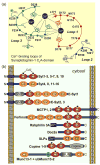Cell biology of Ca2+-triggered exocytosis
- PMID: 20561775
- PMCID: PMC2963628
- DOI: 10.1016/j.ceb.2010.05.001
Cell biology of Ca2+-triggered exocytosis
Abstract
Ca(2+) triggers many forms of exocytosis in different types of eukaryotic cells, for example synaptic vesicle exocytosis in neurons, granule exocytosis in mast cells, and hormone exocytosis in endocrine cells. Work over the past two decades has shown that synaptotagmins function as the primary Ca(2+)-sensors for most of these forms of exocytosis, and that synaptotagmins act via Ca(2+)-dependent interactions with both the fusing phospholipid membranes and the membrane fusion machinery. However, some forms of Ca(2+)-induced exocytosis may utilize other, as yet unidentified Ca(2+)-sensors, for example, slow synaptic exocytosis mediating asynchronous neurotransmitter release. In the following overview, we will discuss the synaptotagmin-based mechanism of Ca(2+)-triggered exocytosis in neurons and neuroendocrine cells, and its potential extension to other types of Ca(2+)-stimulated exocytosis for which no synaptotagmin Ca(2+)-sensor has been identified.
Copyright 2010 Elsevier Ltd. All rights reserved.
Figures




References
-
- Südhof TC. The synaptic vesicle cycle. Annu Rev Neurosci. 2004;27:509–547. - PubMed
-
- Bean AJ, Zhang X, Hokfelt T. Peptide secretion: what do we know? FASEB J. 1994;8:630–638. - PubMed
-
- Lindau M, Gomperts BD. Techniques and concepts in exocytosis: focus on mast cells. Biochim Biophys Acta. 1991;1071:429–471. - PubMed
-
- Randriamampita C, Trautmann A. Ca2+ signals and T lymphocytes; “New mechanisms and functions in Ca2+ signalling”. Biol Cell. 2004;96:69–78. - PubMed
-
- Katz B, Miledi R. Ionic requirements of synaptic transmitter release. Nature. 1967;215:651. - PubMed
Publication types
MeSH terms
Substances
Grants and funding
LinkOut - more resources
Full Text Sources
Miscellaneous

